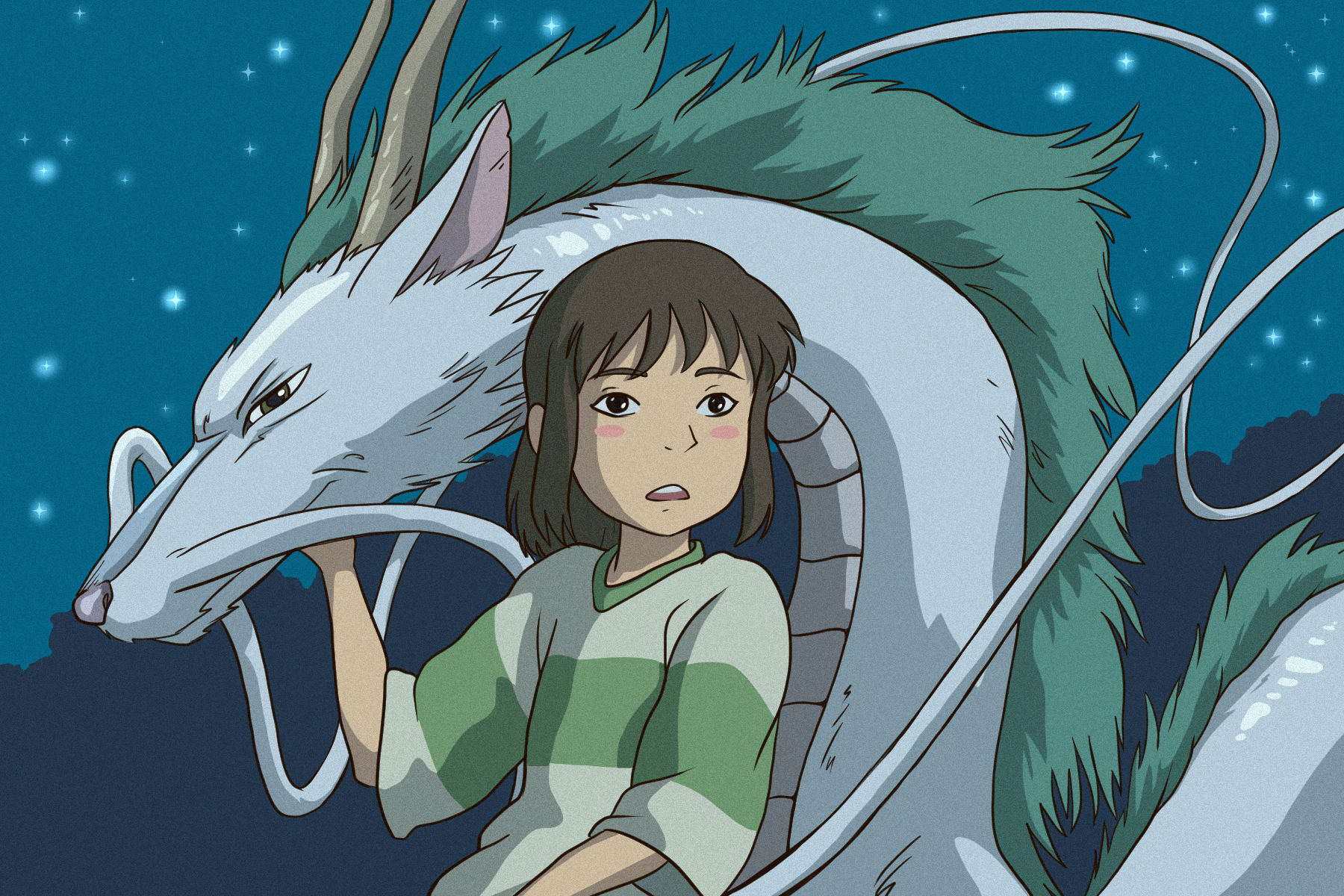A pastel color palette, whimsical characters and hard-to-find toys: What do these all have in common? Each quality pertains to the life of a collector, especially one devoted to the fictional stories of Studio Ghibli. While other fan collections might be stereotyped by “nerdy” action figure displays or expansive comic book collections, the Ghibli franchise reframes what it means to be in a fandom community. In a surprising turn of events, it’s the sweet and subtle love from fans that becomes the investment Studio Ghibli needs to live on in the cultural memory.
For those unfamiliar with the franchise, Studio Ghibli is an animation company originating from Japan. Introduced to the world in 1985 by Isao Takahata, Toshio Suzuki and the ever-popular Hayao Miyazaki, the trio brought a new definition to the category of “humble” animation. While the term anime technically applies to all Japanese animation, the works of Studio Ghibli are not your average fictional films. The emphasis on the “art” of Ghibli animation provides a soft, wonderful gateway into the most beautifully moving stories.
With rich imagery and detail, heightened by loveable characters and even magical beings, the studio gives life to the mundane wonders that are often underappreciated in the mainstream. Although these fictional pieces are derived from animation — something that is easily brushed off as “for kids” — these roots do not discredit the cultural impact of the studio’s works. One of the studio’s most recognizable films, “Spirited Away,” continues to be “the all-time, highest-grossing film in Japan, earning over 30 billion yen at the box office.” But success in their country of origin is only one milestone for the company; these box-office-breaking numbers set off Studio Ghibli’s popularity around the world.
The global touch of an animation company is not new: Think of Pixar’s reach or DreamWorks Animation changing the way people think about a “cartoon” character. However, Studio Ghibli’s position among these animation giants feels different because of the way their fandom rides steady under the social radar. That is, Studio Ghibli fans occupy all nooks and crannies of the world, yet their undying love for the films is revealed in some surprising, non-traditional ways. While sharing wonderful words of praise is one facet of media love, the fans who search out rare collectibles show a different side to that intimate relationship.
One fan gained recent popularity for her record-breaking Studio Ghibli memorabilia. Eloise Jéglot, also referred to by her model name of Eloise Von Velvet, earned the title of “World’s Largest Studio Ghibli Collection” for her four-figure cache of collectibles. The Studio Ghibli superfan owns everything from toys and DVDs, to music boxes and statues. More impressive is the fact that each piece among the 1,000+ items covers a range of Studio Ghibli’s most notable films, such as “Kiki’s Delivery Service” and “My Neighbor Totoro.” Following her record, Guinness World Records recorded a tour of her themed collection on YouTube, peering into the life of the collector.
As Jéglot led Guinness World Records through her “Ghibli Room,” the fan reflected on her first impressions of the franchise: “I fell in love with its magnificent landscape, its beautiful soundtrack and its strong female characters.” The dynamic array of plush “Totoro” animals, the teeny tiny army of “Ponyo” figurines, and the countless cats that are a nod to “Kiki’s Delivery Service,” all imbue Jéglot’s room with character. A dedicated room with floor-to-ceiling shelves is certainly a collector’s dream, but this fan has grown a connection with her collection that makes it memorable. Each item is cherished with a different story behind it, making the viewer realize that these pieces are more than just decoration.
Nevertheless, love for a franchise is not without time and dedication. At first glance, one might question how the French collector was able to acquire the vast limited-edition or anniversary pieces of the Japanese animation company. Screen Rant reflected on the concerns over Jéglot’s hobby habit, considering that “she spends three to five hours per day scouring the internet for any Ghibli item she might not yet have.” Though the shock of the search seems jarring to her peers, the collector views it as an investment into the various ways she can represent her favorite characters in her home.
Jéglot later disclosed to Guinness World Records how far she’ll push the envelope to track down memorabilia: “Sometimes I even wake up in the middle of the night to raise a bid on eBay.” A bit of eye strain and a broken sleep schedule pales in comparison to the rare goods she can find to further her collection. Otherwise, Jéglot would never be in possession of rare Studio Ghibli wood sculptures or a “Cat Bus” that survived shipping and customs. From the way she crafts personal ties to characters to the hours she spends hunting down precious objects, all her efforts come together into a Studio Ghibli lovers paradise.
Beyond the bookcases of items, however, Jéglot reveals one aspect of fan culture that can uplift stories that are not talked about on the daily: collecting. Fans, with their collections in tow, breathe life into the characters that would otherwise remain on a poster or in the confines of a screen. Collecting will never go out of style, but it does enhance the sectors of fandom and fiction that may be lacking in the “social” aspect. In that respect, the Studio Ghibli superfan is not just acquiring fictional merchandise; she is seeking out items from a niche animation studio because these stories have become an integral part of her own life. The diehards, like Jéglot, identify themselves with their collection as much as the media they seek to uphold: “I will never stop collecting because it’s my passion, it’s my life.”
The semi-niche interest of the Studio Ghibli collections might seem common among its fandom community, but it raises questions regarding popularity when ranked against other animation giants of the industry. In today’s media-saturated world, Studio Ghibli definitely has a firm foundation among names like Pixar or DreamWorks. To repeat, despite the international reputation that the studio holds, it still maintains an understated presence to everyone but its fans.
Much of the Ghibli distinction and appeal comes from the way that the animation highlights nature throughout their stories. Whimsy and imagination meld to create the idyllic landscapes featured in each film. Everything from the breezy skies to flowing waters and grassy hillsides pours into the dreamiest scenes of animation. The swoon-worthy reactions from watching these films are heightened by these rarities since they show a side of storytelling that emphasizes nature as a comfort. Studio Ghibli is evidently hailed for these “fictional worlds so seemingly organic, complex and mysterious,” since they are unlike the action-packed or aggressive media that likes to occupy the mainstream attention span.
The glowing, nature-focused perspective of Studio Ghibli films carries back into fan collections, with collectors itching to own a piece of the dreamscape. Even Jéglot’s own “Ghibli Room” exhibits how sacred this rare film style is compared to more “normal” animation, as she claimed, “The landscape is always magnificent. The decor is full of details.” Studio Ghibli takes those notions of an endearing landscape entrenched in carefree moments and offers an animated fiction that makes up for leisure time others might take for granted. The gravity of her collection is just one pillar of a fanbase that seeks out Ghibli films for their version of escapist media.
With the knockout combination of escapism and a pastoral landscape, Studio Ghibli also fuels the ongoing “cottagecore” obsession online. Drenched in sunlight and frolicking through fields, the cottagecore aesthetic of running away to a forest “cottage” gets projected onto these animations. Since one cannot abandon their responsibilities for a secluded life, Ghibli animations became the compromising middle ground for “a rural way of living.” A lovely setting to project even lovelier characters strays far from one’s presumption of animation as merely a “kids” genre. What Studio Ghibli offers is a way to fill the gap of one’s desires for the serene nature setting, packaged in the easy-to-follow format of fiction. The magical characters and the immense wonderment compose a sentiment of “escape” as well, providing a safe space to allow oneself to dream as widely as Miyazaki himself.
Fan collections like Jéglot’s demonstrate how escapist stories continue to form connections with their audiences, even when nature-based fiction occupies a limited space in media. The demand for superheroes and unlikely dystopias seems to always steer the fiction in a narrow direction; yet, exposing how joyous a story can become adds a refreshing perspective to the category. No matter how small or obscure an interest is, animations like Studio Ghibli’s can cater to it. For that reason, scenes “full of heart and magic that makes you want to open your eyes a little wider and watch a little longer” come across as a luxury to take advantage of. To jump on the collector’s train and ride the journey of the Ghibli fanbase is just a sample of how to transform the niche interest into the beloved one.
There’s no doubt that the audience for these films will support their hard-to-find favorites in any capacity. Besides the Ghibli memorabilia that swept the internet, multiple real-life attractions provide an opportunity to step into this world for oneself. The Ghibli Museum in Mitaka happily greets customers with a smiling Totoro, as guests pile into the world of Miyazaki’s creations. Patrons can learn about the growth of the animation through visits, or take a virtual look into a hallmark of Japan’s tourist destinations.
As much as museums provide a factual look into the animation’s history, the real cherry-on-top comes from new announcements for a “Ghibli Park” to open in Japan in November 2022. Fans and guests alike will get to jump into the “sprawling, pastoral inspirations of Ghibli films” as if they were dropped into their favorite scenes. The escapism that Ghibli fans have been waiting for — with their collections and undying love for these remarkable stories — finally gets to be actualized in a park. It is a monumental feat to think that a smattering of feel-good Japanese animations would rise to the heights of theme-park status.
Even though big names like Pixar and DreamWorks have carved a reputation for themselves in worldwide media, Studio Ghibli fans offer a sweeter approach to fanaticism. While there’s still a definite portrayal of movie-typical tropes in Miyazaki’s films — things like friendship, love or inner growth — these animations combine escapism and nature’s beauty in an unlikely yet welcoming way. Physical collectibles are transformed from mere figurines to the ultimate reverence for such visionary storytelling. The time and place for fiction to paint dystopias beyond imagination will never grow out of style; yet Studio Ghibli fulfills the yearning for a softer, dreamier and oh-so-cozy playground one didn’t realize they needed.

















